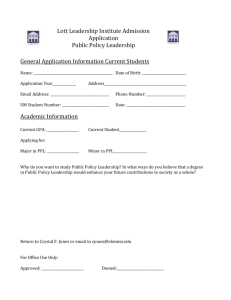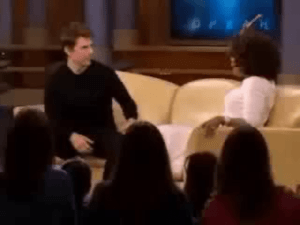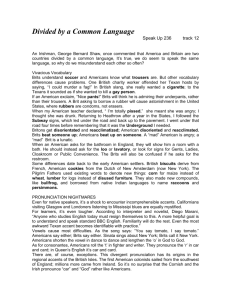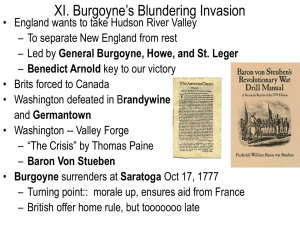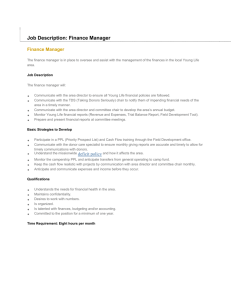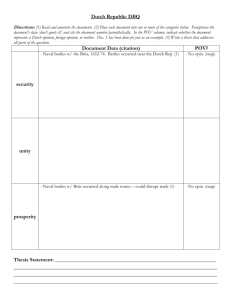Click here for final review by Talia Menche
advertisement
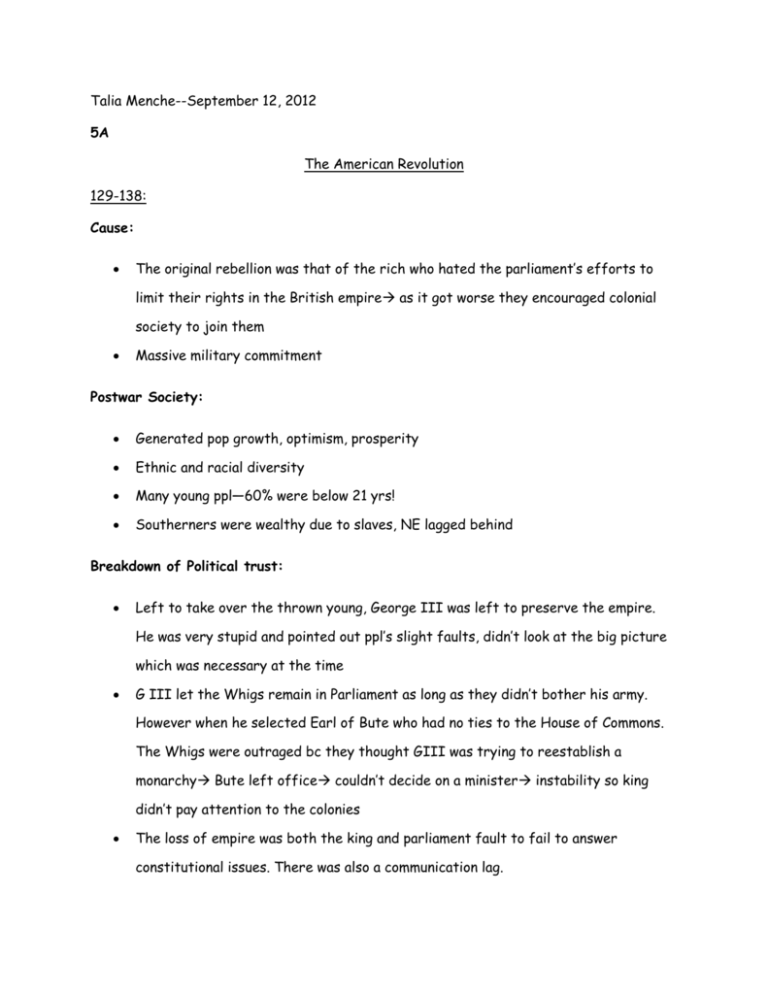
Talia Menche--September 12, 2012 5A The American Revolution 129-138: Cause: The original rebellion was that of the rich who hated the parliament’s efforts to limit their rights in the British empire as it got worse they encouraged colonial society to join them Massive military commitment Postwar Society: Generated pop growth, optimism, prosperity Ethnic and racial diversity Many young ppl—60% were below 21 yrs! Southerners were wealthy due to slaves, NE lagged behind Breakdown of Political trust: Left to take over the thrown young, George III was left to preserve the empire. He was very stupid and pointed out ppl’s slight faults, didn’t look at the big picture which was necessary at the time G III let the Whigs remain in Parliament as long as they didn’t bother his army. However when he selected Earl of Bute who had no ties to the House of Commons. The Whigs were outraged bc they thought GIII was trying to reestablish a monarchy Bute left office couldn’t decide on a minister instability so king didn’t pay attention to the colonies The loss of empire was both the king and parliament fault to fail to answer constitutional issues. There was also a communication lag. Misunderstandings- Brits thought that parliament was the dominant element in the constitution but sharing sovereignty didn’t make sense to the colonists. American Views: Colonists defended the powers of provincial assemblies—made many policies (since Britain didn’t care about them) (Unlike in England where representatives were not necessarily voted on rather the colonists believed the reps should chosen or else their not legit) CT Assembly: no law can b made w/o the consent of the ppl by their reps. Political Virtue: Colonist had a moral component to their vies that American Loyalists( Americans who sided with the king) didn’t understand John Locke: 17th c philosopher (2 treaties of govt), claimed that all ppl had natural rights—life, liberty and property ppl liked his way of linking religion and spiritual defense of govt. Colonist liked the idea of commonwealth—John Trenchard and Thomas Gordonassured ppl that power was dangerous and would destroy liberty unless it had virtue/good morals.-> thought govt was sinning Public virtue- sacrifice of self-interest to the public good. Ppl began to think that the British were sinners they were ready to resist England via war. Ideas spread via newspaper Challenge and Resistance: 7 yrs War put Brits in huge debt and although they should have disbanded their army GIII insisted on having one loss of $. Colonist weren’t worries about Brits army bc: they didn’t have enough troops in America ex: Pontiac led an uprising with western Indians who allied with French and hated the Brits Brits was unable to defend themselves, this was a destructive uprising for the Native Americans in terms of land and also ppl were racist towards them Paxton boys killed Christian Indians and threatened to continue into Philadelphia if anyone criticized them Proclamation of 1763- prohibited governors from granting land beyond the headwaters of rivers going into the Atlantic viewed the legislation ad hurtful to the economy Paying off debt: George Grenville was GIII’s chancellor (after Bute) and he said the only way Eng could get out of debt was with the help of the colonists. He made the Revnue/ sugar act which discouraged smuggling, bribery and other illegit things that prevented the Navigation Acts (forced America to trade almost exclusively with Brits) from making profit!--> Americans saw this as injust but did not respond with violence. Stamp Act and boycott: Stamp Act 1765 was parliaments plan to get 60,000 euro out of the colonists a year by making them buy special seals or stamps to validate legal documents. When word got out to America of the Brits plans they were very mad. Patrick Henry introduced 5 resolutions protesting the Stamp act (Virginia Resolves) but he was stopped when he was accused of treason. His ideas spread through the news. Stamp Act congress of 1765 took place in October in NY. All colonies were present and stated their distaste for the taxes and Stamp Act. Nov of 1765—stamp distributors in almost all American ports resigned, and w/o distributors the stamps couldn’t be sold! Youth in the colonies used to rebel against Catholics and now redirected it to England. They attacked Andrew Oliver- a local stamp distributor. Sons of Liberty encouraged ppl to boycott British goods until the Stamp Act was repealed. (Boycotts also brought women together even though they couldn’t vote they were part of the political culture. Saving Face: Grenville fell from power and was replaced by Rockingham who wanted an expanding commerce and local gov’t under the Parliament. He also wanted to repeal the Stamp Act but knew he couldn’t do this yet in his position so he tried to merchants in Eng to petition it Feb 1766, the House of Commons repealed the Stamp Act made the Declaratory Act to ensure Americans of Brits power. Americans lost respect for imperial officers 140-142 Townshend, Tax, and Hillsborough: After Rockingham William Pitt, or Earl of Chatham took the gov’t head. While he was sick, however Charles Townshend made decisions and policies. He told ppl he knew how to obtain income from the Americans parliament was please and voted to lower Brits land taxes budget crises. Townshend Revenue Acts taxed colonists on glass, paint, led, paper, and tea so that Brits could collect enough $ and could free themselves from the colonies dependence.--> unsuccessful created American Board of Customs Commissioners Townshend told NY that they had to veto all colony bills until it gave, according to the Quartering act, homes to British troops. Americans: no taxation without representation Sons of Liberty boycotted at ports. Many ppl took oaths not to buy British goods. Massachusetts House of Reps drafted a letter with suggestions to prevent the Townshend acts. They sent this on and most ppl ignored it but Lord Hillsborough, England’s secretary, thought this was a form of treason.--> Mass dissolved their House of Reps which compelled other colonies to support them, assemblies in many colonies dissolved. 92= symbolic for patriotism (# of ppl who voted against Hillsborough). The colonies then became what the Brits feared, more united via communication. Patriotic Martyrs: Brits sent troops from Nova Scotia to Boston. Why? It isn’t clear but the redcoats were treated badly and were underpaid. Colonists thought it was tyrannical troops moved to Boston Harbor. Lord North took over for Townshend. He repealed the Townshend duties which hurt English manufacturers—by taxing the Americans the Brits only encouraged them to start their own businesses—so Townshend ideas were dropped with the exception of tea (to ensure, once again, their power) 5b September 19, 2012—Talia Menche American Revolution 142-148 Last Days of Old Order: Colonial merchants returned to normal trade patterns. British goods came into the colonies and A’s were thankful. Customs commissioners were corrupt and abused their powers. They enforced the Navigation acts. They often harassed the rich drove rich to oppose the Brits ppl in RI burned the Gaspee,a customs vessel, A’s were pleased Samuel Adams didn’t accept that the repeal of the Townshend duties had secured A’s liberty. He kept this issue alive and reminded A’s they were being taxed on tea. Many people listened to him and he created a committee to express A’s view. He got political cooperation w/o a royal gov’t. The Boston Tea Party/Final Provocations: May 1773 Parliament passed the Tea Act- EIC sold directly to A’s eliminating tax paid in England. Brits made it to save the East India Company from bankruptcy. Before, the EIC imported Asian tea to England where it was subject to heavy tax so A’s got cheaper from Holland Failure: since the tax on tea was collected in A’s ports they thought this was another way of Brits getting the tax no tax w/o rep. Also it threatened to undercut those merchants who traded/smuggled Dutch goods. In Phili and NYC A’s turned back the ships ASAP. In Boston, Governor Hutchinson didn’t let A’s turn back Brits ships but A’s wouldn’t unload them. Dec 16, 1773, a group of men disguised as Mohawks boarded the ships and threw 342 chests of tea overboard (could’ve been organized by Sam Adams). Brits angered by the Boston tea party made the Coercive (intolerable) acts- where they 1. Closed the port of Boston until they compensated the EIC for the lost tea. 2. Restructured the Massachusetts gov’t by transforming the upper house from an elective to an appointed body and could only have 1 town meeting a yr. 3. Allow the royal governor to transfer any arrested Brit officials to England (where they’d less likely b convicted) 4. Authorized the army to draft troops wherever they needed. General Tom Gage was the new royal governor. Brits tried to separate Boston from A’s but A’s sent help and didn’t allow it. Quebec Act- Parliament announced plans to reestablish a new vil gov’t in Quebec. This act failed to create an elective assembly and also gave French Roman Catholics large political power. Quebec extended into the U.S A’s upset Colonial Response: First Continental congress: consisted of 55 elected delegates from 12 colonies (not GA). It took place in Phili on Sept 5th. Difference of opinions—Middle colonies wanted to proceed w/ caution unlike Sam Adams who was more radical, wanted confrontation Suffolk Resolves- encouraged resistance of the Coercive acts. “Association”—an intercolonial agreement to stop commerce with England until Parliament repealed the intolerable acts, enforces no importation. War begins: Shot goes off at Lexington and Concord war begins 2nd Continental congress- formed the continental Army led by G Washington. They were assuming the powers of sovereign gov’t but didn’t declare independence. Used paper $. December 1775- Parliament passed the prohibitory act, declaring war on American commerce Americans couldn’t trade with anyone in the world b/c Brits blocked their ports and seized their ships. Brits hired German mercenaries to put down rebellion. Road to Independence: Thomas Paine writes the essay Common Sense which spread rapidly. Stated that monarchs ruled by force, attacked mixed and balance constitution. This essay was a powerful democratic proposal.—persuaded common ppl to stop their loyalty to Britain. July 2, 1776, Congress voted for independence. All 12 states were for it. Thomas Jefferson wrote the Declaration of Independence which was accepted 2 days later—presented evidence for independence All men are created equal 6C Talia Menche October 14, 2012 175-180 When trade started again with England ppl realized they needed a central gov’t. The arts of confederation were at default—wouldn’t allow congress to tax. Constitutional reforms (made by Hamilton, Madison and Morrison)- Congress could collect 5% tax on imported goods sold in the states, impost of 1781 America grew desperate for a central gov’t, Brits and Spain were bothering them for not paying their debt but A couldn’t get $. Baron de Montesquieu (French) - a republican gov’t cant flourish in a large territory. James Madison (Virginia) rejected this; he thought that in a big republic the society becomes broken into many interests. A gov’t based on the will of the ppl yet detached from narrowly based demands. Shay’s rebellion- poor farmers in Massachusetts worked very hard but were always in debt to the westarmy put down rebellion and new reps were voted to support Shay (symbolized the break down in order. Purpose of the Constitutional Convention: Gathered in may 1787 Participants- 55 men representing 12 states-not RI- came to Phili. Mostly in their 30’s40’s. included: Washington, Madison, George Mason, Rob Morris, James Wilson, John Dickenson, Ben Franklin and Alex Hamilton (Adams and Jefferson were not). Procedures- 1.decided nothing spoken would be printed or communicated without leave. 2. Delegates decided to vote by state, but proposals needed support of majority, not 9 like arts New Jersey & Virginia: Madison’s idea presented by Ed Randolph: made the Virginia plan- new federal system determined to restrain state assemblies and gave federal gov’t power to veto state laws. National legislature would have 2 houses- one chosen by the ppl and the other chosen by the ppl elected in the 1st. provided an executive elected by congress. (some feared small states would lose power w/ Virginia plan) William Paterson, a lawyer, came up with the New Jersey plan. It consisted of a legislature in which each state had one vote and also Congress had a new power to tax and regulate trade. Rejected. Compromises: 3/5 Compromise- to help determine the representation in the lower house, slaves would count as 3/5 a person (gave south power) Great Compromise- states are equally rep’d in the upper house of congress while representation in the lower house was proportionate. (?) Terms of Office: president would be selected by an electoral college (men in each state chosen by the ppl). The # of electoral votes that each state got equaled its # of senators and rep’s. Whoever got 2nd most votes was VP. If there was no majority lower house would decide, each state having one vote. Delegates also had power to veto legislation and nominate judges. 6d Talia Menche October 16, 2012 185-189 Ratification: Method: They called for the election of 13 state conventions to review the new federal gov’t (got idea from Massachussettes). The constitution will pass with the consent of 9 states. Governor Morris changed the wording to ‘we the people’ a new nation was a republic of ppl and not states.--Signed by 39 Federalist Response: Federalists- didn’t want one nation and authority, wanted a confederation of states- support constitution. Often wrote about their views. Anti Federalists- opponents sometimes threatened. They were suspicious of political power—the larger the republic greater corruption. They were afraid they wouldn’t have any connection to their reps and that the rich would be favored Federalist response- they told the antis that A would be rep’d by ppl with greater knowledge and skills, they were not tied to selfish needs. Federalists often lived in more commercial areas unlike anti who were often the farmers etc. Constitution ratified between 1787-88 by all states other than NC and RI Bills of Rights: The bill of rights did what the antis wanted, it secured minority against the tyranny of the majority. Antis demanded guarantees for jury trial and religion. Antis wanted to call a 2nd constitutional congress so they could adjust it more (to be like the bills) but Madison didn’t let.--> he took their ideas into account, presented it to the house of reps and came up with a bill of rights (10 amendments)—ratified in 1791 (2 yrs after it was passed in both Congress homes) 7A Talia Menche November 5, 2012 7a: 200-208 Census: Why? The constitution called for the gov’t to have a census every 10 years. Who? Included all whites. Didn’t include Indians (b/c they weren’t taxed nor rep’d) and counted blacks as 3/5. Distinguished white males over 16 from younger, heads oh homes from dependents, slaves from free citizens and men from women Was going to ask for occupation but they felt that ppl would get upset didn’t. Thomas Jefferson, the secretary of state, was in charge of administrating it. He sent marshals out to count. Problems: 1. census counters made many mistakes. 2. Some men and women rejected the census (even though they were fined. 3. Ppl rejected the census b/c in the bible God was mad at David for doing a census. Outcome: 1. Increased the # of rep’s from 65100. 2. Brought legitimacy to gov’t struggle ----------------------------------------------------------------------------------------------------- Judiciary Act of 1789- made a Supreme Court with a chief justice with 5 assistants and 13 district courts. Tarrif of 1789- 5% tax on imports- makes a lot of $ but there’s controversy: South felt there was discrimination against them Jefferson vs. Hamilton: Both of them were in the first cabinet, were veterans of war, and well respected Hamilton- was not for wealth but for reputation. Wanted a strong central gov’t and did not want to be bound to the constitution. Admired British culture and the thought we should be closer w/ the Brits in terms of commerce and diplomacy. -Believed in bold commercial development, complex financial work. Believed the country’s best hope was the rich who could be reassured by the gov’t and then would help strengthen it. No conflict between private greed and public good. Jefferson- not as popular. Didn’t want power or wealth rather to advance in democratic principles (like Dec. of I). Inspired by French rev and would pick French over British. Believed economy should come from agricultural productivity. Felt that ppl could shape policy, believed in common folk, felt politicians should follow Constitution. The greatest danger was ppl who valued order and power over liberty upper class=dangerous. -strength of the economy lays in the agriculture (farmer will help expand the international market). However he still believes in change within agriculture. He had faith in A’s to shape policy. Insisted on following the Constitution. Thought rich were threat. Both: creation of a strong republic Hamilton’s Plans: Report on the Public Credit: Hamilton becomes the first secretary of the treasury and had the responsibility of shaping the economy (even developed a questionnaire to better understand how it worked). Made 3 major reports on public credit, banking, and manufacturers. Report on the Public Credit showed that the nation’s debt was about $54 million; states owned creditors about $25 million and ppl keep selling gov’ts debt. Report on the Public Credit: 1. US promised to fund its foreign and domestic values fully 2. The secretary urged the fed gov’t to assume responsibility for paying the remaining state debts. Goals: 1. Reduce the power of the individual states 2. To show other countries that America was now in the money and they could therefore trust them w/ bonds Hamilton asked the wealthy to invest in the U.S’s future. Criticism: 1. Madison worried about regular citizens who now had to sell their certificates at a low price (which rich would benefit from). 2. Some states already paid their debt so now the ones who didn’t were kind of getting rewarded. 3. Thought it was just to increase the power of the rich/ Hamilton’s friends Some of the protesters however were against it bc they were looking to buy land and thought the assumption would cut off cut-rate securities. Washington signed assumption and funding into law. Bank Controversy: Hamilton proposed the U.S gov’t make a national bank that would be funded by the federal gov’t. He said a growing financial community needed a central bank. Also the gov’t would issue currency accepted in payment of taxes. Protest: Madison and more argued that Hamilton was misinterpreting the constitution. Washington was concerned about all the controversy so he asked opinions from the cabinet members but Hamilton’s persuaded him for it anyway. Washington signed the bank act into law in 1791. Public began to fear Hamilton’s actions. It led to many serious bankruptcies. Report on Manufacturers/Setback: In this report Hamilton stated ways which the gov’t could help stimulate manufacturing. He believed in order for the U.S to separate itself from dependence on European exports we had to make stuff here. Protective tariffs and special industrials bounties would help boost this growth. Protest: his opponents engaged him on more political ideas then economic—believed he would leave states defenseless. Also gov’t shouldn’t promote development of these workers. If this happened country workers would move to urban lands. GW was very upset that ppl argued so much 8b 242-250 European conflict: During J’s 2nd term, France and GB were at war both at sea and on land. (Napoleon crushed GB on land). America in the beginning, when it was neutral, benefited economically from both F and GB. However, it was hard for them to trade with F so then took “broken voyages” where A ships went out of F Caribbean ports to F. But eventually GB named these voyages illegal GB started seizing A ships. Orders in council: proclamations issued by GB that forbade neutral commerce with the Continent and threatened seizure of ships that violated this. F responded to this with the blockade called the continental system. Berlin and Milan decree- Napoleon announced the closing of continental ports to British trade (cut GB out of a large market). It also declared that neutral vessels carrying GB goods would be liable to seizure GB ordered A ships to stop in GB to pay on their way to the Continent but Napoleon was determined to seize these ships. A wasn’t ready to join a war and didn’t. A ship of the Royal Navy, the leopard, commanded an A warship to search for traitors. When the captain refused the Leopard open fired! American Recourse: Embargo Act- “peaceable coercion”- since F and GB refused to respect A’s neutrality, A wouldn’t trade to either of them. (never really affected GB) Enforcement acts: when violations occurred Congress had the right to seize the vessel. Also, it was now forbidden to load a UD vessel without special authorizationppl very upset. Some NE’s began to join the fed party, republicans in congress panicked. (-Republican congressman chose Madison easily, who beat Pinckney) Non- Intercourse act- it let US resume trade with all countries besides GB and F. Either of this countries could get trade with A by simply recognizing A’s neutrality. -GB (Erskine-GB minister to US) agreed but then when A traded with them GB seized A ships! Macon’s Bill #2- (sponsored by Nathaniel Macon of NC) it re-established trade with both GB and F, however, as soon as either of these countries repealed restrictions on shipping US would stop trading with that country Napoleon said he would repeal the Berlin and Milan decrees Madison announced that if GB didn’t remove the Order of council then US would cut off commercial relations w them. However what Madison didn’t know is Napoleon still seized US ships! But he ignored this A’s hated British bc Brits were instructing Indians from Canada to stop A’s expansion American vs. Indians at battle of Tippecanoe where I’s seeked GB help Starting War: Ppl in US hated the BritsAggressive nationalists called War Hawks. 1812 Madison sent a declaration of war on GB to Congress. Why? 1. Wanted Brits to respect A marine rights Strategy: Canada. Canada supplied Caribean Brits with a lot of their food. Madison thought that by threatening to seize Canada, US might compel GB to compromise naval problems. -- (election of 1812: Clinton vs. Madison, Madison wins) War of 1812: Republicans believed that US could sweep GB out of Canada but what they didn’t realize was war was very expensive and US wasn’t very prepared. Ppl in New England didn’t want to cooperate with war, they kept on trading with the enemy, they didn’t lend US any $GB didn’t block Northern ports Battles: A focused on west: General Hill of US had to surrender to a smaller Brit force in Detroit On the sea A did better. 1. Isaac Hull’s Constitution beat Brits as soon as there was peace Brits blockaded the US navy 2.Perry destroyed Brit ship Brits came from Canada to NY As came and Brits retreated Chesapeake: Brits harassed the coast (in response to A’s destroying Upper Canada) Brits burned DC attacked all Baltimore but gave up. 9A 455-467 Industrialization and Expansion: Steamboats were starting to be sued as a mode of transportation led to industrialization Brits withdrew from Ohio yet they continued to claim the Pacific NW. Spain still had FL. New states: Ohio, KY, TN, and Louisiana. However, I’s still had a lot of good land. Goal: 1st goal of expansion was to get FL. Jackson crossed thru east FL to pursue mean I’s occupied this area, gov’t opposed this move but they didn’t discipline. Secretary Adams told Spanish gov’t that US was acting in self-defense and would only stop if given East FL. Adams-Onis Treaty- Spain gave up FL and in return we gave them $5 mil. Spain also gave up its claim to the Pacific Coast north of Cali, opening path for more expansion. Also they agreed to create a new boundary in Texas. John Jacob Astor- founded the fur-trading post of Astoria in Oregon and limited the company to trading with Indians (but later relied on them) Rich lands between Appalachians and Mississippi were opened Mississippi: In the Ohio Valley and NW territory military defeat I’s. Most tribes were eventually forced west of Mississippi (sometime say national programs). Jefferson suggested that removal would let those I’s who wanted to become “civilized” apply for citizenship. Some ppl didn’t agree In south there were treaties that negotiated and provided eventual removal of Indians. States began forced removal. 8 new western states. Financial panic—wealthy got good land. Settlers and culture: Many farmers moved out west since their land was overworked, they often moved in families to re-create their old lives. NE’s moving mid west brought Puritan idea of hard work and respected the gov’t. Southerners moved to the lower mid west were devoted to personal/family honor, less committed to authority and institutions. It was difficult using only family labor shared work with a number of families or sometimes had slaves do very difficult labor. Those who remained in the East imagined the West as uncivil and full of I’s. Transportation: Roads and Boats: Pres Madison called for a federally supported programs of “internal improvements: National Road: first great fed transportation project. Included the Lancaster Turnpike between Phili and Pittsburg. Charged toll but toll plus maintenance didn’t create a sufficient profit. Flatboat could float down but was difficult to return Robert Fulton and Livingston created an intense steamboat called the Clermont. 1st steamboat launched in the west was the New Orleans. This boat helped ppl travel and western commerce! steam transport was great for farmers and merchants. It reduced cost and increase the speed of goods and ppl. it also allowed a 2-way commerce on Mississippi and Ohio Canals: Needed a way to trade in transatlantic trade or to the growing urban market of coast states. The Erie Canal- credit to NY’s governor De Witt Clinton. It reduced the cost of moving goods within NY. Lowered the cost of Western products in the east but made prices decline in goods sold from east to west. NYC= commerce capital. This canal inspired other states Penn Mainline Canal as made but didn’t work as well Illinois Michigan Canal- linked Chicago and the great lakes w/ IL and Mississippi. The canal boom ended when it was obviously not profitable Market Economy: Increase in agriculture output due to technology. Also b/c they now had good land and if their land got bad they could move west! Concentrate on central crops like N sell lots of wheatmoved west Deep South produced a lot of cotton b/c: 1. Great demand due to textile manufacturing in England and New England. 2. Cotton gin. 3. Good land available in SW. 4. Slavery, forced labor. South and less need for canals and roads Commerce and Banking: Farmers began selling their crops to local markets who then sold those commodities. Credit- the ppl selling the farmers goods charged interest but it was more than the farmer doing it on their ownencouraged the growth of $ and banking Long-distance deals involved credit and delayed payment which required a lot of $ gov’t didn’t print paper $ just small amounts of coins which didn’t meet the economies needs. Private/state banks issued blank notes (promise to redeem their paper in coins). Increase in # of banks Congress made Bank of US in 1816, check on state banks but it didn’t do this wellthey over extended the creditfinancial panicdepression. Industrialism: Growth in market economyled to speed, quantity, and standardization in the methods of productions Manufacturing was carried out at home-“putting-out” system. Mostly done in NE. Shops expanded in size Factories emerged in the textile industry Lowell figured out how to create a power loom. He also made another mill in Massachusetts and one in Chicopee. 1830’s-40’s mills changed for the worse-more work and lower pay
